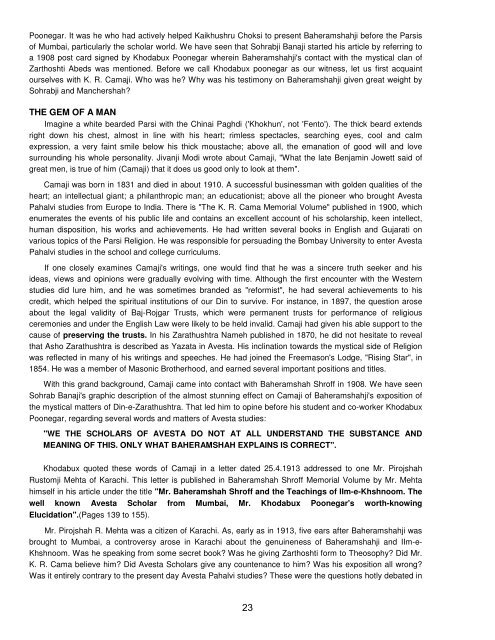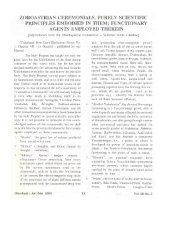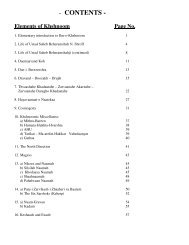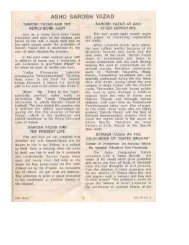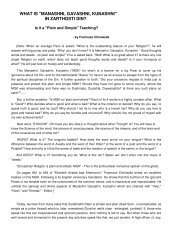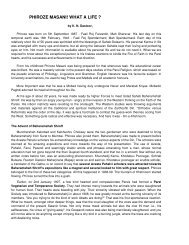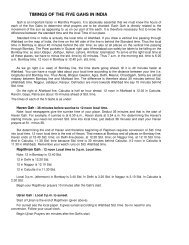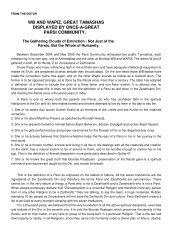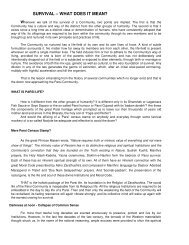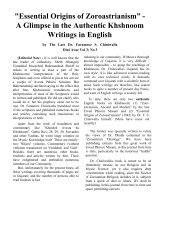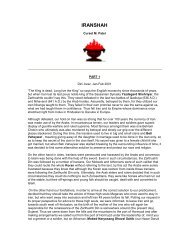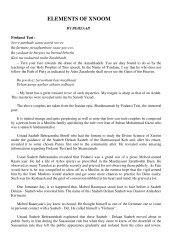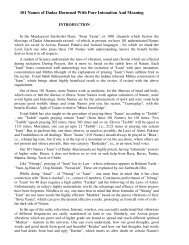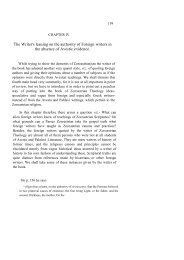Ilm-e-Khshnoom - Traditional Zoroastrianism: Tenets of the Religion
Ilm-e-Khshnoom - Traditional Zoroastrianism: Tenets of the Religion
Ilm-e-Khshnoom - Traditional Zoroastrianism: Tenets of the Religion
Create successful ePaper yourself
Turn your PDF publications into a flip-book with our unique Google optimized e-Paper software.
Poonegar. It was he who had actively helped Kaikhushru Choksi to present Baheramshahji before <strong>the</strong> Parsis<br />
<strong>of</strong> Mumbai, particularly <strong>the</strong> scholar world. We have seen that Sohrabji Banaji started his article by referring to<br />
a 1908 post card signed by Khodabux Poonegar wherein Baheramshahji's contact with <strong>the</strong> mystical clan <strong>of</strong><br />
Zarthoshti Abeds was mentioned. Before we call Khodabux poonegar as our witness, let us first acquaint<br />
ourselves with K. R. Camaji. Who was he? Why was his testimony on Baheramshahji given great weight by<br />
Sohrabji and Manchershah?<br />
THE GEM OF A MAN<br />
Imagine a white bearded Parsi with <strong>the</strong> Chinai Paghdi ('Khokhun', not 'Fento'). The thick beard extends<br />
right down his chest, almost in line with his heart; rimless spectacles, searching eyes, cool and calm<br />
expression, a very faint smile below his thick moustache; above all, <strong>the</strong> emanation <strong>of</strong> good will and love<br />
surrounding his whole personality. Jivanji Modi wrote about Camaji, "What <strong>the</strong> late Benjamin Jowett said <strong>of</strong><br />
great men, is true <strong>of</strong> him (Camaji) that it does us good only to look at <strong>the</strong>m".<br />
Camaji was born in 1831 and died in about 1910. A successful businessman with golden qualities <strong>of</strong> <strong>the</strong><br />
heart; an intellectual giant; a philanthropic man; an educationist; above all <strong>the</strong> pioneer who brought Avesta<br />
Pahalvi studies from Europe to India. There is "The K. R. Cama Memorial Volume" published in 1900, which<br />
enumerates <strong>the</strong> events <strong>of</strong> his public life and contains an excellent account <strong>of</strong> his scholarship, keen intellect,<br />
human disposition, his works and achievements. He had written several books in English and Gujarati on<br />
various topics <strong>of</strong> <strong>the</strong> Parsi <strong>Religion</strong>. He was responsible for persuading <strong>the</strong> Bombay University to enter Avesta<br />
Pahalvi studies in <strong>the</strong> school and college curriculums.<br />
If one closely examines Camaji's writings, one would find that he was a sincere truth seeker and his<br />
ideas, views and opinions were gradually evolving with time. Although <strong>the</strong> first encounter with <strong>the</strong> Western<br />
studies did lure him, and he was sometimes branded as "reformist", he had several achievements to his<br />
credit, which helped <strong>the</strong> spiritual institutions <strong>of</strong> our Din to survive. For instance, in 1897, <strong>the</strong> question arose<br />
about <strong>the</strong> legal validity <strong>of</strong> Baj-Rojgar Trusts, which were permanent trusts for performance <strong>of</strong> religious<br />
ceremonies and under <strong>the</strong> English Law were likely to be held invalid. Camaji had given his able support to <strong>the</strong><br />
cause <strong>of</strong> preserving <strong>the</strong> trusts. In his Zarathushtra Nameh published in 1870, he did not hesitate to reveal<br />
that Asho Zarathushtra is described as Yazata in Avesta. His inclination towards <strong>the</strong> mystical side <strong>of</strong> <strong>Religion</strong><br />
was reflected in many <strong>of</strong> his writings and speeches. He had joined <strong>the</strong> Freemason's Lodge, "Rising Star", in<br />
1854. He was a member <strong>of</strong> Masonic Bro<strong>the</strong>rhood, and earned several important positions and titles.<br />
With this grand background, Camaji came into contact with Baheramshah Shr<strong>of</strong>f in 1908. We have seen<br />
Sohrab Banaji's graphic description <strong>of</strong> <strong>the</strong> almost stunning effect on Camaji <strong>of</strong> Baheramshahji's exposition <strong>of</strong><br />
<strong>the</strong> mystical matters <strong>of</strong> Din-e-Zarathushtra. That led him to opine before his student and co-worker Khodabux<br />
Poonegar, regarding several words and matters <strong>of</strong> Avesta studies:<br />
"WE THE SCHOLARS OF AVESTA DO NOT AT ALL UNDERSTAND THE SUBSTANCE AND<br />
MEANING OF THIS. ONLY WHAT BAHERAMSHAH EXPLAINS IS CORRECT".<br />
Khodabux quoted <strong>the</strong>se words <strong>of</strong> Camaji in a letter dated 25.4.1913 addressed to one Mr. Pirojshah<br />
Rustomji Mehta <strong>of</strong> Karachi. This letter is published in Baheramshah Shr<strong>of</strong>f Memorial Volume by Mr. Mehta<br />
himself in his article under <strong>the</strong> title "Mr. Baheramshah Shr<strong>of</strong>f and <strong>the</strong> Teachings <strong>of</strong> IIm-e-<strong>Khshnoom</strong>. The<br />
well known Avesta Scholar from Mumbai, Mr. Khodabux Poonegar's worth-knowing<br />
Elucidation".(Pages 139 to 155).<br />
Mr. Pirojshah R. Mehta was a citizen <strong>of</strong> Karachi. As, early as in 1913, five ears after Baheramshahji was<br />
brought to Mumbai, a controversy arose in Karachi about <strong>the</strong> genuineness <strong>of</strong> Baheramshahji and IIm-e-<br />
<strong>Khshnoom</strong>. Was he speaking from some secret book? Was he giving Zarthoshti form to Theosophy? Did Mr.<br />
K. R. Cama believe him? Did Avesta Scholars give any countenance to him? Was his exposition all wrong?<br />
Was it entirely contrary to <strong>the</strong> present day Avesta Pahalvi studies? These were <strong>the</strong> questions hotly debated in<br />
23


